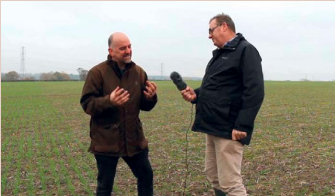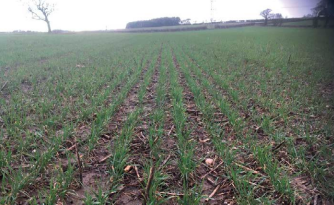Well, what a winter it has been, with the wettest February on record I can safely say it is the wettest season I have ever seen. My heart goes out to all the people who have been affected by the floods and those farmers who have had land under water for weeks on end.

On a positive note, it has been a pleasure here to see the soil infiltrate all this water and even after the heaviest of storms, the soil can still cope with more infiltration. In my mind, this goes to prove the more carbon sequestration we can achieve, the healthier the planet.
Carbon becomes a sponge within the soil holding more water for times of need, but also holding water back from our rivers. I firmly believe that our rivers are only in need of dredging due to the soil erosion from our fields. Low carbon and insubstantial soil structure, along with high bacterial soil levels mean there is little or no fungi to produce the glomalin glue which holds nutrients together. Thus, there is little in the soil to retain excess water in conventionally cultivated soils, resulting in soil erosion and nutrient loss from the soil into our rivers. This in turn culminates in dead zones from eutrophication across our oceans and seas. With conservation agriculture I am proving this doesn’t have to be the case.
Additionally, as a planet we need to clean up our act of polluting water because it is a finite resource, we cannot obtain any more and pollutant levels seem to be continually rising. There is even evidence to suggest that excreted pharmaceutical drugs (e.g., Prozac) entering the water course are having an adverse effect on plants’ growth, inhibiting their root production and inhibiting shoot development (“Plant Intelligence” by Stephen Harrod Buhner). This book has proved to be an interesting read revealing that plants produce serotonin (100 times more than any animal brain) which is essential for maintenance, physiological and morphogenic (form and structure) processes. These include light responses, root hair development, lateral root and shoot system development. When the plant is under stress, serotonin production in the plant tissues increase, resulting in alterations in root architecture – Aren’t plants amazing?
Now, I haven’t got all the answers of how to clean up our planet, but what I do believe is that healthy soils produce healthy nutritious food, which contributes to healthy people. Investment in soil health may be a wiser long-term investment for a healthier population and improved planetary environment. “Food Matters TV” (“FMTV”) is an informative site where food is used to prevent and cure all ills, without intervention from the medical world of pharmaceuticals. I believe that in the future, the consumer will be able to monitor nutrient dense food and will pay a premium for it. Dan Kitteridge is such a person already working on spectrometers to measure food nutrient densities. For nutrient dense food to be produced, soil needs to be healthy with welladjusted bacteria to fungi ratio and high carbon content.
As is also the case with plant production, I can stop most disease and pest problems by working with nature, with the use of nutrition and biology. From the coming year I am hoping to carry some wheat through to harvest with no herbicides apart from post drilling glyphosate. This will be a first for me. My soils keep improving, with less and less unwanted plant growth (“weeds”), since they are not needed because the soil is always covered with a cover crop. Farming with nature and not against it, as life is always easier when you work with nature.

With the help of my biological agronomist, Nick Woodyatt (Edaphos) we have come up with the programme this year which will eliminate the use of fungicides. As we proved last year it can be done. This gives me the confidence to rely on it more for the coming season. This will be alongside the correct nutrition as done correctly we have eliminated PGRS and strengthened the cell wall of the plant to protect against fungal attack. We found last year on the T3 spray on the untreated fusarium was 36% on the treated with Bacillus it was 2%. This is a double whammy: higher levels of control than we would have had with fungicides, but more importantly we are not carrying spores over into the following crop.

Without the use of fungicides straw is cycled far quicker in soil as fungi can do its job and break the lignin down within the straw. It becomes a far better product for soil health. Fungicides are very similar to insecticides; I am finding that once you use one you are then on the hamster wheel that you have to continue because you have stripped the leaf of its natural resistance, which then makes it more vulnerable to fertiliser scorch. Whereas using biology (bacillus) we are again working with nature and its own natural defences. Nature has all the answers; it’s just we thought we could do better. We are now learning that we cannot, and I firmly believe that this will be the century in farming known as the biological farming century. There is so much to learn and we are just on the tip in my opinion.

Oilseed rape companions of berseem clover and white are looking healthy, with the clover nodulating well. All winter crops will start off with a trace element blend in order to get the plant ready for its nitrogen application so that it can utilise it correctly. There has been a lot of talk in the press to get nitrogen on early. I cannot see the point if the plant has not got the tool kit within itself to utilise the nitrogen which then results in more pollution and carbon burning. Putting nitrogen on will result in a green looking crop, but in my experience, it will have poor rooting which will be devastating when we hit a dry period which is inevitable after all this rain (in my opinion). Also, with all that top growth a PGR will be a must, as the cell walls will be weak and open to fungal attack.
Birdlife on the farm continues to expand with the conservation agriculture policies implemented. Monitoring skills from the local bird ringing group (Belvide Bird Ringers) help to identify the variety in birdlife. Over 50 different bird species have been spotted or heard on the farm; 27 different bird species ringed; 4 of these species are on the British Trust of Ornithology amber endangered list and over 12 of these species are on the endangered red list. There were 85 breeding pairs of skylarks on the farm. Nest boxes around the farm had 90% occupancy of great tits and blue tits rearing clutches of between 8 – 10 chicks, which goes to prove the abundance of food found on the farm in order to sustain such large numbers. The bird group was aired on Radio 4’s Farming Today on Monday 9th March, if you get a chance to listed back to it.
I wish us all a favourable and productive Spring.